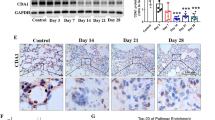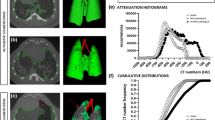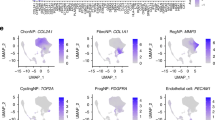Abstract
Fibrosis, the replacement of healthy tissue with collagen-rich matrix, can occur following injury in almost every organ1,2. Mouse lungs follow a stereotyped sequence of fibrogenesis-to-resolution after bleomycin injury3, and we reasoned that profiling post-injury histological stages could uncover pro-fibrotic versus anti-fibrotic features with functional value for human fibrosis. Here we quantified spatiotemporally resolved matrix transformations for integration with multi-omic data. First, we charted stepwise trajectories of matrix aberration versus resolution, derived from a high-dimensional set of histological fibre features, that denoted a reversible transition in uniform-to-disordered histological architecture. Single-cell sequencing along these trajectories identified temporally enriched ‘ECM-secreting’ (Csmd1-expressing) and ‘pro-resolving’ (Cd248-expressing) fibroblasts at the respective post-injury stages. Visium-based spatial analysis further suggested divergent matrix architectures and spatial–transcriptional neighbourhoods by fibroblast subtype, identifying distinct fibrotic versus non-fibrotic biomolecular milieu. Critically, pro-resolving fibroblast instillation helped to ameliorate fibrosis in vivo. Furthermore, the fibroblast neighbourhood-associated factors SERPINE2 and PI16 functionally modulated human lung fibrosis ex vivo. Spatial phenotyping of idiopathic pulmonary fibrosis at protein level additionally uncovered analogous fibroblast subtypes and neighbourhoods in human disease. Collectively, these findings establish an atlas of pro- and anti-fibrotic factors that underlie lung matrix architecture and implicate fibroblast-associated biological features in modulating fibrotic progression versus resolution.
This is a preview of subscription content, access via your institution
Access options
Access Nature and 54 other Nature Portfolio journals
Get Nature+, our best-value online-access subscription
$32.99 / 30 days
cancel any time
Subscribe to this journal
Receive 51 print issues and online access
$199.00 per year
only $3.90 per issue
Buy this article
- Purchase on SpringerLink
- Instant access to full article PDF
Prices may be subject to local taxes which are calculated during checkout






Similar content being viewed by others
Data availability
Single-cell transcriptomic, epigenomic and spatial-transcriptomic data are available on the Gene Expression Omnibus (GEO) at accession number GSE250398. The 10X Genomics Cell Ranger mm10-3.0.0 reference genome was utilized for alignment, for which build notes can be found at https://www.10xgenomics.com/support/software/cell-ranger/downloads/cr-ref-build-steps. CODEX data are available at https://github.com/HageyLab/PF2025. Source data are provided with this paper.
Code Availability
Data processing scripts are available at https://github.com/HageyLab/PF2025.
References
Talbott, H. E., Mascharak, S., Griffin, M., Wan, D. C. & Longaker, M. T. Wound healing, fibroblast heterogeneity, and fibrosis. Cell Stem Cell 29, 1161–1180 (2022).
Wynn, T. A. Fibrotic disease and the TH1/TH2 paradigm. Nat. Rev. Immunol. 4, 583–594 (2004).
Glasser, S. W. et al. Mechanisms of lung fibrosis resolution. Am. J. Pathol. 186, 1066–1077 (2016).
Glassberg, M. K. Overview of idiopathic pulmonary fibrosis, evidence-based guidelines, and recent developments in the treatment landscape. Am. J. Manag. Care 25, S195–S203 (2019).
Michalski, J. E., Kurche, J. S. & Schwartz, D. A. From ARDS to pulmonary fibrosis: the next phase of the COVID-19 pandemic? Transl. Res. 241, 13–24 (2022).
Xie, T. et al. Single-cell deconvolution of fibroblast heterogeneity in mouse pulmonary fibrosis. Cell Rep. 22, 3625–3640 (2018).
Tsukui, T. et al. Collagen-producing lung cell atlas identifies multiple subsets with distinct localization and relevance to fibrosis. Nat. Commun. 11, 1920 (2020).
Adams, T. S. et al. Single-cell RNA-seq reveals ectopic and aberrant lung-resident cell populations in idiopathic pulmonary fibrosis. Sci. Adv. 6, eaba1983 (2020).
Kheirollahi, V. et al. Metformin induces lipogenic differentiation in myofibroblasts to reverse lung fibrosis. Nat. Commun. 10, 2987 (2019).
Mascharak, S. et al. Desmoplastic stromal signatures predict patient outcomes in pancreatic ductal adenocarcinoma. Cell Rep. Med. 4, 101248 (2023).
Foster, D. S. et al. Multiomic analysis reveals conservation of cancer-associated fibroblast phenotypes across species and tissue of origin. Cancer Cell 40, 1392–1406.e7 (2022).
Mascharak, S. et al. Preventing Engrailed-1 activation in fibroblasts yields wound regeneration without scarring. Science 372, eaba2374 (2021).
Coelho, P. G. B., de Souza, M. V., Conceição, L. G., Viloria, M. I. V. & Bedoya, S. A. O. Evaluation of dermal collagen stained with picrosirius red and examined under polarized light microscopy. An. Bra. Dermatol. 93, 415–418 (2018).
Mao, Q., Wang, L., Goodison, S. & Sun, Y. Dimensionality reduction via graph structure learning. In Proc. 21st ACM SIGKDD Conference on Knowledge Discovery and Data Mining (eds Cao, L. & Zhang, C.) 765–774 (2015).
Trapnell, C. et al. Pseudo-temporal ordering of individual cells reveals dynamics and regulators of cell fate decisions. Nat. Biotechnol. 32, 381 (2014).
Organ, L. A. et al. Biomarkers of collagen synthesis predict progression in the PROFILE idiopathic pulmonary fibrosis cohort. Resp. Res. 20, 148 (2019).
Jin, S. et al. Inference and analysis of cell–cell communication using CellChat. Nat. Commun. 12, 1088 (2021).
Morse, C. et al. Proliferating SPP1/MERTK-expressing macrophages in idiopathic pulmonary fibrosis. Eur. Resp. J. 54, 1802441 (2019).
Shen, M., Luo, Z. & Zhou, Y. Regeneration-associated transitional state cells in pulmonary fibrosis. Int. J. Mol. Sci. 23, 6757 (2022).
Enomoto, Y. et al. LTBP2 is secreted from lung myofibroblasts and is a potential biomarker for idiopathic pulmonary fibrosis. Clin. Sci. 132, 1565–1580 (2018).
Travaglini, K. J. et al. A molecular cell atlas of the human lung from single-cell RNA sequencing. Nature 587, 619–625 (2020).
Wang, S. et al. S100A8/A9 in inflammation. Front. Immunol. 9, 1298 (2018).
Cui, L. et al. Activation of JUN in fibroblasts promotes pro-fibrotic programme and modulates protective immunity. Nat. Commun. 11, 2795 (2020).
Guan, R. et al. Bone morphogenetic protein 4 inhibits pulmonary fibrosis by modulating cellular senescence and mitophagy in lung fibroblasts. Eur. Resp. J. 60, 2102307 (2022).
Buschman, M. D. & Field, S. J. MYO18A: an unusual myosin. Adv. Biol. Reg. 67, 84–92 (2018).
Wang, L. et al. CCAAT/enhancer-binding proteins in fibrosis: complex roles beyond conventional understanding. Research 2022, 9891689 (2022).
Xu, Y. et al. Transcriptional programs controlling perinatal lung maturation. PLoS ONE 7, e37046 (2012).
Swonger, J. M., Liu, J. S., Ivey, M. J. & Tallquist, M. D. Genetic tools for identifying and manipulating fibroblasts in the mouse. Differentiation 92, 66–83 (2016).
Ghasemi, M., Seidkhani, H., Tamimi, F., Rahgozar, M. & Masoudi-Nejad, A. Centrality measures in biological networks. Curr. Bioinformatics 9, 426–441 (2014).
Hermenean, A. et al. Galectin 1—a key player between tissue repair and fibrosis. Int. J. Mol. Sci. 23, 5548 (2022).
Gremlich, S. et al. Tenascin-C inactivation impacts lung structure and function beyond lung development. Sci. Rep. 10, 5118 (2020).
Qiu, X. et al. Reversed graph embedding resolves complex single-cell trajectories. Nat. Methods 14, 979–982 (2017).
Alsafadi, H. N. et al. An ex vivo model to induce early fibrosis-like changes in human precision-cut lung slices. Am. J. Physiol. 312, L896–L902 (2017).
Santoro, A. et al. SERPINE2 inhibits IL-1α-induced MMP-13 expression in human chondrocytes: involvement of ERK/NF-κB/AP-1 pathways. PLoS ONE 10, e0135979 (2015).
Lupsa, N. et al. Skin‐homing CD8+ T cells preferentially express GPI‐anchored peptidase inhibitor 16, an inhibitor of cathepsin K. Eur. J. Immunol. 48, 1944–1957 (2018).
Black, S. et al. CODEX multiplexed tissue imaging with DNA-conjugated antibodies. Nat. Protoc. 16, 3802–3835 (2021).
Wu, X. et al. Regulating the cell shift of endothelial cell-like myofibroblasts in pulmonary fibrosis. Eur. Resp. J. 61, 2201799 (2023).
Habermann, A. C. et al. Single-cell RNA sequencing reveals profibrotic roles of distinct epithelial and mesenchymal lineages in pulmonary fibrosis. Sci. Adv. 6, eaba1972 (2020).
Tsukui, T., Wolters, P. J. & Sheppard, D. Alveolar fibroblast lineage orchestrates lung inflammation and fibrosis. Nature 631, 627–634 (2024).
Buechler, M. B. et al. Cross-tissue organization of the fibroblast lineage. Nature 593, 575–579 (2021).
Liu, X. et al. Multiple fibroblast subtypes contribute to matrix deposition in pulmonary fibrosis. Am. J. Resp. Cell Mol. Biol. 69, 45–56 (2023).
Hallowell, R. W., Amariei, D. & Danoff, S. K. Intravenous immunoglobulin as potential adjunct therapy for interstitial lung disease. Ann. Am. Thorac. Soc. 13, 1682–1688 (2016).
Southam, D. S., Dolovich, M., O’byrne, P. M. & Inman, M. D. Distribution of intranasal instillations in mice: effects of volume, time, body position, and anesthesia. Am. J. Physiol. 282, L833–L839 (2002).
Henderson, W. R. et al. Inhibition of Wnt/β-catenin/CREB binding protein (CBP) signaling reverses pulmonary fibrosis. Proc. Natl Acad. Sci. USA 107, 14309–14314 (2010).
Stuart, T., Srivastava, A., Madad, S., Lareau, C. A. & Satija, R. Single-cell chromatin state analysis with Signac. Nat. Methods 18, 1333–1341 (2021).
Korsunsky, I. et al. Fast, sensitive and accurate integration of single-cell data with Harmony. Nat. Methods 16, 1289–1296 (2019).
Mo, Y. et al. Intratracheal administration of mesenchymal stem cells modulates lung macrophage polarization and exerts anti-asthmatic effects. Sci. Rep. 12, 11728 (2022).
Urbanek, K. et al. Intratracheal administration of mesenchymal stem cells modulates tachykinin system, suppresses airway remodeling and reduces airway hyperresponsiveness in an animal model. PLoS ONE 11, e0158746 (2016).
Govek, K. W. et al. Single-cell transcriptomic analysis of mIHC images via antigen mapping. Sci. Adv. 7, eabc5464 (2021).
Csardi, G. & Nepusz, T. The igraph software package for complex network research. InterJournal 1695, 1–9 (2006).
Acknowledgements
This work was supported by the Hagey Laboratory for Pediatric Regenerative Medicine (to D.C.W. and M.T.L.), the Stanford Translational Research and Applied Medicine Pilot Grant (to J.L.G.), NIH grant R01-GM136659 (to M.T.L.), NIH grant RM1-HG007735 (to H.Y.C.), NIH fellowship F32-HL167318 (to J.L.G.), the Scleroderma Research Foundation (to H.Y.C. and M.T.L.), the Wu Tsai Human Performance Alliance (to M.T.L.) and the Cell Science Imaging Facility (CSIF) at Stanford Medicine.
Author information
Authors and Affiliations
Contributions
J.L.G., M.G., J.-K.Y., S.M., H.Y.C, D.C.W., T.J.D. and M.T.L. conceptualized the project. J.L.G., M.G., J.-K.Y., Y.Z., J.M.L., H.Y.C. and T.J.D. designed various biological methodologies (for example, tissue processing, characterization and sequencing). J.L.G., S.M. and M.J. developed bioinformatic analyses (for example, histological and spatial analysis). J.L.G., M.G., J.-K.Y., D.M.L., Y.Z., J.M.L., G.M., J.B.L.P., C.B., N.J.G., D.B.A., D.J.L., C.V. and N.E.L. carried out biological experiments (for example, animal work, cell and tissue collection, staining and imaging). J.L.G., M.G., J.-K.Y., D.M.L., Y.Z. and J.B.L.P. contributed to data analysis. J.L.G., M.G., J.-K.Y., D.M.L. and Y.Z. carried out data visualization and figure design. H.Y.C., D.C.W., T.J.D. and M.T.L. contributed to supervision of the project. All authors contributed to writing, review and editing of the manuscript. H.Y.C., D.C.W., T.J.D. and M.T.L. provided scientific and laboratory resources. J.L.G., H.Y.C., D.C.W. and M.T.L. acquired funding in support of the project.
Corresponding author
Ethics declarations
Competing interests
The authors declare no competing interests.
Peer review
Peer review information
Nature thanks Michael Matthay and the other, anonymous, reviewer(s) for their contribution to the peer review of this work.
Additional information
Publisher’s note Springer Nature remains neutral with regard to jurisdictional claims in published maps and institutional affiliations.
Extended data figures and tables
Extended Data Fig. 1 Alveolar cells and fibroblasts exhibit differential signaling and enrichment during fibrosis and post-fibrotic resolution.
(A) Specific ligand-receptor interactions between fibroblasts and either alveolar type II (ATII) or type I (ATI) cells. Fibroblast-ATII interactions at PID 14 are inferred to be largely similar to fibroblast-ATI interactions at PID 35 (red box). (B) Timepoint-specific differences in alveolar cells primarily consist of an established ATII-ATI transitional signature (Clu/Krt8/Krt18) enriched in ATI cells at PID 35. (C) Pdgfra, Col1a1, and Col3a1 expression by fibroblast subtypes. ECM-secreting fibroblasts (red boxes) exhibit notably higher average expression of Col1a1 and Col3a1 compared to other fibroblast subtypes. (D-F) Timepoint-dependent enrichment (D), top 3 differentially expressed genes (E), and top 10 gene ontology terms (F) of fibroblast subtypes. Red boxes indicate the relevant fibroblast subtype. P-values calculated based on the two-tailed Fisher’s exact test in enrichR.
Extended Data Fig. 2 Pro-resolving fibroblast delivery enhances in vivo resolution of fibrosis.
(A) Delivery of freshly FACS-sorted fibroblasts to mice for investigation of functional impact. Created with BioRender. Guo, J. https://BioRender.com/l13t441 (2025). (B) Impact of fibroblast subtype enrichment during peak fibrosis on downstream collagen content (left; n = 3 mice for post-injury day [PID] 21 and all baseline timepoints; n = 4 mice for all other treatments and timepoints) (Lin-: p = 0.294/0.438/0.750/0.688; Pro-Resolving: p = 0.043/0.049/0.696/0.688; ECM-Secreting: p = 0.600/0.873/0.696/0.688; for PID 28/35/42/49, respectively, vs. baseline), matrix architecture (middle; n = 5 mice) (Lin-: p = 0.035/0.004/0.027/0.851; Pro-Resolving: p < 0.0001/0.0001/0.0001/p = 0.0004; ECM-Secreting: p = 0.484/0.806/0.243/0.383; for PID 28/35/42/49, respectively, vs. baseline), and immature collagen staining (right; n = 5 mice) (Lin-: p = 0.125/0.636/0.502/0.913; Pro-Resolving: p = 0.005/0.179/0.306/0.710; ECM-Secreting: p = 0.009/0.001/0.706/0.036; for PID 28/35/42/49, respectively, vs. baseline). Pro-resolving fibroblasts help accelerate post-fibrotic resolution when enriched at PID 21. * indicates statistically significant difference from baseline at same timepoint (p < 0.05). (C) Immunofluorescence of instilled tdTomato+ fibroblasts after PID 21 indicates that both ECM-secreting and pro-resolving fibroblasts integrate within the interstitium, largely within less fibrotic areas. Orange arrows indicate subtype-positive instilled cells, while blue arrows indicate subtype-negative instilled cells. Results are representative of n = 3 independent experiments. (D) FACS quantification suggests that instilled fibroblasts proliferate from post-delivery day 1 to 7 (Pro-Resolving: p = 0.010/0.010; ECM-Secreting: p = 0.002/0.048; for post-delivery day 7/14, respectively, vs. day 1), with ECM-secreting fibroblasts losing their original phenotype during the post-fibrotic phase (Pro-Resolving: p = 0.355/0.140; ECM-Secreting: p < 0.0001/0.0001; for post-delivery day 7/14, respectively, vs. day 1) (n = 3 mice for post-delivery day 1 and 14; n = 4 mice for post-delivery day 7). * indicates statistically significant difference from post-delivery day 1 (p < 0.05). For panels B and D, p-values are based on ANOVA with post-hoc testing by Fisher’s least significant difference and Benjamini-Hochberg correction (all tests two-tailed), while all values are displayed as mean ± standard deviation.
Extended Data Fig. 3 In situ cell proportions and spatial interactions vary by post-injury stage.
(A) Cell proportions at PID 14 and 35, normalized to baseline. (B-C) -Log10 normalized P values of differential interactions in fibrotic lungs (B) and differential interactions between fibrotic and post-fibrotic lungs (C). For panels B and C, p-values were calculated by an unpaired, two-tailed t-test.
Extended Data Fig. 4 Alveolar cells and fibroblasts strongly influence tissue-level cellular organization in fibrotic and resolving lungs.
(A) Eigenvector centrality scores at PID 14 and 35, representing influence of individual cell types on tissue-level cellular organization. ATI cells, ATII cells, and fibroblasts constitute the highest-scoring nodes at both stages. (B-C) -Log10 normalized P values of differential fibroblast-alveolar cell interactions in fibrotic lungs (B) and differential fibroblast-alveolar cell interactions between fibrotic and post-fibrotic lungs (C). For panels B and C, p-values were calculated by an unpaired, two-tailed t-test.
Extended Data Fig. 5 Fibroblast subtypes are inferred to reside in cellular niches that are either relatively immune/endothelium-adjacent or fibroblast-adjacent.
(A) Identification of cellular niches associated with each fibroblast subtype. ECM-secreting and pro-resolving fibroblasts appeared to occupy distinct niches that are comparatively immune/endothelium-adjacent (Spatial Niche A, top box) or fibroblast-adjacent (Spatial Niche B, bottom box), respectively. (B) Fibroblast subtype-associated signaling pathways in CellChat. ECM-secreting fibroblasts are involved in pro-fibrotic pathways such as Collagen and Spp1 (red box), while pro-resolving fibroblasts are involved in other pathways such as Galectin and Tenascin (blue box).
Extended Data Fig. 6 ECM-secreting and pro-resolving fibroblasts are enriched in regions of fibrotic and non-fibrotic histological architecture, respectively.
(A) Mapping of matrix architecture onto Visium to identify spatially enriched cellular/transcriptional features. (B) Correlation of localized cell-cell interactions with matrix architecture and stained matrix quantity in all bleomycin-treated lungs. Top 5 positively and negatively correlated interactions are shown, suggesting that regions of fibrotic architecture are predominantly associated with communities of ATI cells, fibroblasts, and macrophages (box). (C) Fibroblast subtypes enriched in regions of differential matrix pseudotime and matrix quantity, demonstrating that ECM-secreting and pro-resolving fibroblasts are localized in regions of high and low matrix pseudotime, respectively (boxes). Conversely, ECM-secreting and baseline alveolar fibroblasts are the most enriched subtypes in regions of high and low matrix quantity, respectively, suggesting that quantification of matrix architecture may elucidate unique biological features not apparent based on analysis of matrix quantity alone.
Supplementary information
Supplementary Figures
Supplementary Figs. 1–6.
Supplementary Tables
Supplementary Tables 1–10. Supplementary Table 1 contains the rationale for annotation of overall single-cell transcriptomic populations. Supplementary Table 2 shows differentially expressed genes by single-cell transcriptomic populations, including up to 200 genes that meet the defined thresholds (see Methods). Supplementary Table 3 shows differentially expressed genes by fibroblast subtypes, including up to 200 genes that meet the defined thresholds. Supplementary Table 4 contains the top 10 gene ontology terms associated with the differential gene expression of each fibroblast subtype. Supplementary Table 5 contains the top 200 differentially accessible chromatin peaks and their closest genes at post-injury days 14 and 35, specifically associated with fibroblasts. Supplementary Table 6 contains the top 10 gene ontology terms associated with the chromatin accessibility of fibroblasts at post-injury days 14 and 35. Supplementary Table 7 contains the top 200 most enriched DNA motifs at post-injury days 14 and 35, specifically associated with fibroblasts. Supplementary Table 8 contains the co-variant transcriptional signatures defined by spatial correlation (Pearson coefficients) with localized ATI-fibroblast subtype interactions and matrix pseudotime. Supplementary Table 9 includes a list of the antibodies utilized for CODEX, immunofluorescence and FACS. Supplementary Table 10 contains the rationale for annotation of overall CODEX populations.
Rights and permissions
Springer Nature or its licensor (e.g. a society or other partner) holds exclusive rights to this article under a publishing agreement with the author(s) or other rightsholder(s); author self-archiving of the accepted manuscript version of this article is solely governed by the terms of such publishing agreement and applicable law.
About this article
Cite this article
Guo, J.L., Griffin, M., Yoon, JK. et al. Histological signatures map anti-fibrotic factors in mouse and human lungs. Nature 641, 993–1004 (2025). https://doi.org/10.1038/s41586-025-08727-3
Received:
Accepted:
Published:
Issue date:
DOI: https://doi.org/10.1038/s41586-025-08727-3
This article is cited by
-
The spatial and temporal activation of macrophages during fibrosis
Nature Reviews Immunology (2025)



